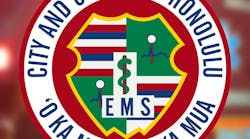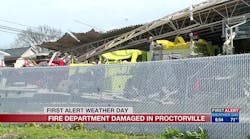As I sat down at my computer to begin work on this little session with you, I was torn in a number of directions. What should I discuss with you? What might be a lesson I learned during the past few days? I had many ideas running around in my head.
Should I write about some great moment that occurred during my career that taught me a lesson in how to share wisdom on interpersonal relationships? On the other hand, should I apply my talents to something technical that I saw or experienced at the Expo? Alternatively, should I share something with you from my career in the fire service? I had this same trouble a couple of summers ago. Then it came to me in a flash!
My choice this week was really simple. I need to write a word or two telling you folks that you should stop sitting on the sidelines and start jumping into the world of making decisions. I see a number of problems on the horizon for the fire service that will require critical decisions to be made. Sadly, the making of decisions is not everyone's cup of tea.
I am a long time veteran of the wars when it comes to making bad-decisions. The list of miscues in my life is long and ignoble. However, what is initially a mistake at one point in time can become a valuable source of experience for future use.
My wife has long told the world, or at least those who would listen, that I really have no business telling anyone about decisions. No way, not time and no how.
Perhaps she is right. It took me four tries before I decided to finally retire from the Newark Fire Department back in 1999. I guess that I am not a stellar maker of critical decisions.
The decision tree for that episode went something like this. Should I retire or should I stay on the fire department? Stay; go; don't stay, don't go. So it went for a number of months, during which time, people started to decide that good-old Chief Carter was never going to leave, and that he also had trouble making the big decisions. They even began to run pools when I announced I was retiring. One pool involved deciding whether I would leave or not which required choosing the date when I would pull my papers. Oddly enough the old fire director won that one.
To make a pathetically long story somewhat shorter, I did finally retire. In retrospect, the decision to leave was obvious, based upon a dispassionate review of the historical data. However, let me tell you that decisions like this are hardly dispassionate in the close and personal sense. Now for what I think is the critical part of this commentary.
How does anyone of us come to the point when they are deemed to be qualified to make decisions? That is a tough call. You first have to realize that any given decision is not just a single act or moment in time. It is a process, because making a single decision is not the important thing. The problem that stimulates us to make a decision is really the core of the decision.
Rare is the situation that occurs in a vacuum, devoid of any ties to the rest of your life. It has been my experience that you must first come to realize that any one small decision is usually linked to the next. This is the concept known as the decision chain. It is through the mechanism of these decision chains that you can form the basis for your success in any aspect of fire service operations.
It has been my good fortune to work with a real expert in the area of decision-making. My co-author for the text, Management in the Fire Service, 3rd Edition, is Mr. Erwin Rausch, a veteran of the private sector, and a long-time management consultant. He had a great deal of experience in the corporate world in setting up decision-making programs. In our text, we grouped these decision chains into three distinct groups:
- Problem-Solving Chains
- Opportunity-Exploiting Chains
- Project-Management Chains
Decisions made under the opportunity-exploiting chain normally do not have the same level of urgency found with the problem-solving chain. In this case the decision is driven by question of the difference between what is and what could be. That is why these are called opportunity-exploiting chains. Rather than solving a problem you are creating an opportunity for your organization to improve in some way.
If you are aware of an organization that does not need to improve, please drop me a note. I would be really interested in seeing just who amongst you sees something as having achieved the goal of perfection.
What I am suggesting to you is really quite simple. I believe that an effective decision is one that involves the maximization of benefit for the agency. In order to be effective, the decision must be based on a reflective review of the organization, as it actually exists. These are the sorts of decisions that allow you to advance to the next level of organizational success
Decisions that are made under the project-management chain cover the day-to-day operations of the fire department, as well as any special projects that may be ongoing. These may be routine decisions, such as determining which inspections will be conducted next week, or buying the diesel fuel for your pumpers, or the toilet paper for your stations.
I would like to also point out that decisions of this type could possibly lead you to develop special projects such as a regional response plan involving shared fire stations, or new programs combining the forces of several agencies. It might even be that you look toward a long-range apparatus replacement plan based upon common apparatus specifications for several agencies. Imagine the cost savings that could come from building many units to the same set of specifications. Opportunities abound to make your department better, if you have the guts to make the right decisions.
It's been my belief for a long time now that a person's success as a leader is defined by the ability to make good day-to-day decisions. Let me stress that the primary thing that you must recognize is that for any decision to occur, or any progress to be made, you have to own up to the fact that a problem exists. If you do not see a problem, you cannot solve a problem.
Unfortunately, people sometimes tend to react to problems with an air of ignorance or denial. I see this among many who fail to recognize the problems facing the fire service at the national level. Things are changing and not for the better.
What I see right now is that the established order is being eaten away rapidly by the forces of Homeland Security. I see the problem and I write about the problem, however there are those who accuse me of being the Chicken Little of the Fire Service. Ladies and gentlemen of the fire service, the sky is truly in danger of falling if we fail to come together and begin operating as a team.
However, I see the concept of denial at work. Some of the ways in which people deal (or do not deal) with problems are:
- Deny that a problem exists
- Camouflage the problems
- Blame someone else
Once you own up to the fact that a problem exists, you will need to have a plan for making the necessary decisions in your life. We have developed a seven-step plan for making decisions within our personal and professional lives:
- Recognize that a problem exists
- Analyze the data surrounding the situation
- Develop alternative solutions which seem to fit the situation
- Evaluate the alternatives to see which one will probably fit your needs best
- Choose one
- Do it
- Evaluate the feedback and make adjustments as necessary
The first step in the problem-solving process is the simplest and most important. You must admit that a problem exists. Once you get this step, you can begin to get to work developing a positive solution.
The second step in the problem-solving process involves defining the problem. It is critical that you confirm that a problem really exists. Once you have done that you need to define that problem in written form. This helps to focus your thinking.
The third step in problem solution is the part where you begin to analyze the problem. You must work to get the whole story. Facts are critical. You should review the record, and then find out what rules, customs, and procedures apply. You should then talk with all of the people involved in the situation. This is critical. You need to gather opinions, facts, and feelings. You need to ask people the following questions:
- What did you see?
- What did you hear?
- What did you say?
You can then decide on your method of attacking the problem. You can choose to solve it yourself, without outside assistance. On the other hand, you might choose to call a conference with the key people. It is possible that you could delegate the investigation to another person or form a committee to study the situation. Lastly there are those who decide to can in an outside consultant to assist you in attacking the problem.
As you work to develop alternative solutions, do not jump to conclusions, or use the first solution you find. You should fit the facts together and then consider how they will interact. Which thing that you see is the real cause of the problem and which is just the symptom of the problem? Which will respond to aspirin and which will require a trip to the doctor?
Review existing policies and procedures for possible pre-existing solutions. Some things that you perceive to be new problems may have been solved a long time ago. Check to see if this is the case. You must then consider any potential affects upon people and the organization. Consider all possible alternatives. This is called brainstorming. Bring your people together and ask them to think. As they begin to emerge from the minds of your people figure out how to put their ideas to work. Oh, and by the way, be sure to listen to your people. Do not blow them off.
Above all it is critical to ask yourself if all of the alternatives are realistic? What good is a solution if it bears no resemblance to the problem you have identified, or if it will not fit within the framework of your department? What good is hiring more people if you have no place for them to work and no equipment or apparatus for them to use?
The fourth step may well be the most difficult. You must do something. You must take an action. Do not try to pin the tail of blame on someone else's donkey. That is what makes me mad with President Bush right now. He has several problems and is seeking to lay them off on someone else. He is the chief, let him stand up and take the responsibility.
You will need to select the best alternative for the situation at hand. Then you must then decide if you are going to attempt to do the job yourself or if you need help. There are some other questions that you will need to answer. Should you kick the solution of the problem up to your boss? Alternatively, is it within the capability of your team to do it? Whichever way it goes, it is critical to do something!
The fifth step is also critical. You must check for results. Follow up will tell you how well you are doing. How soon should you follow up? If the task is critical, checking soon is good. How often should you check? Often enough to insure that the desired results are being achieved. Not so often that your people think that you do not trust them. You must watch for changes in output, attitudes, and relationships.
At this point you will need to ask a critical question. Did you solve the problem? If you can safety say the word Yes, then let me offer my congratulations. However, if the answer turns out to be NO, then I would suggest that you use one of the other alternatives you identified.
However there is every reason to believe that in some instances you will come up short and be unable to solve the problem. If that is the case, then you will have to start the problem-solving process all over again. I am here to tell you that if this happens, are sure to start at the very beginning of the formula. Do not skip any steps. Work the system until you get it right. That will equal a solved problem.
It may be difficult to remember all of the steps. I would strongly recommend you commit them to memory. At the very least write them down. Create a checklist if you must. I would also recommend that that you use them in order. Do not jump steps or jump to obvious conclusions. This can lead to problems, and problems are what you are attempting to solve with your decision-making process.
I have come to one critical conclusion. After spending a lot of years making decisions it still does not get easier. Thankfully, I can work the process better, but at some point I must stand up and choose to do something. Do not duck out on any decision. A decision not consciously made is a decision made by default.
Stand up and be counted. Learn how to make a decision. Your people will thank you.





